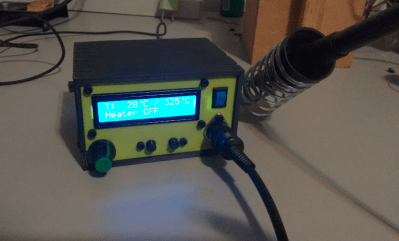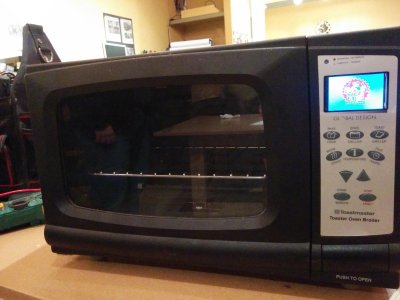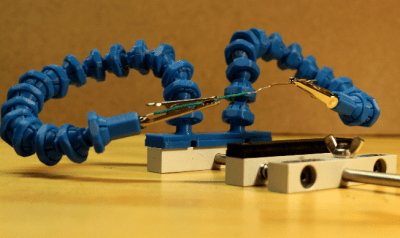If there is one tool every hardware hacker needs, it’s a good soldering setup. Soldering irons, heat guns, reflow ovens and the like make up the tools of the trade for building electronic circuits. Spend enough time working with a tool, and you’ll find a way to improve it. It’s no surprise that hackers, makers, and engineers have been hacking their soldering tools for decades. This week’s Hacklet features some of the best soldering tool projects on Hackaday.io!
 We start with [Kuro] a Hakko 907 based Soldering Station. Hakko 907 and 936 soldering station clones from the Far East are available all over the internet. While the heaters work, none of them have very good temperature controllers. [Kuro] turned a problem into a project by building his own soldering station. These irons are rated for 24 V. 24 volt power supplies are not very common, but it’s easy to find old 19 volt supplies from discarded laptops. [Kuro] found that the lower voltage works just fine. An Arduino nano controls the show, with user output displayed on a 2 line LCD. The finished controller works better than the original, and probably would give a real Hakko model a run for its money.
We start with [Kuro] a Hakko 907 based Soldering Station. Hakko 907 and 936 soldering station clones from the Far East are available all over the internet. While the heaters work, none of them have very good temperature controllers. [Kuro] turned a problem into a project by building his own soldering station. These irons are rated for 24 V. 24 volt power supplies are not very common, but it’s easy to find old 19 volt supplies from discarded laptops. [Kuro] found that the lower voltage works just fine. An Arduino nano controls the show, with user output displayed on a 2 line LCD. The finished controller works better than the original, and probably would give a real Hakko model a run for its money.
 Next up is [Sukasa] with Reflow Oven. When MakerSpace Nanaimo needed a reflow oven, [Sukasa] jumped in with this design. The idea was to create an oven that looked unmodified – just think of it as the toaster oven of the future, or the reflow oven of today. A Netduino plus 2 is the main controller. User information is displayed on a color TFT LCD. This oven is even internet connected, with an internally hosted web page and JSON data feed. The Netduino controls two beefy Solid State Relays (SSRs). The SSRs handle the dirty work of switching the oven’s heating elements. Two fans keep air moving to avoid hot spots. Precision temperature sensing is achieved through a pair of Adafruit MAX31855 breakout boards reading thermocouples.
Next up is [Sukasa] with Reflow Oven. When MakerSpace Nanaimo needed a reflow oven, [Sukasa] jumped in with this design. The idea was to create an oven that looked unmodified – just think of it as the toaster oven of the future, or the reflow oven of today. A Netduino plus 2 is the main controller. User information is displayed on a color TFT LCD. This oven is even internet connected, with an internally hosted web page and JSON data feed. The Netduino controls two beefy Solid State Relays (SSRs). The SSRs handle the dirty work of switching the oven’s heating elements. Two fans keep air moving to avoid hot spots. Precision temperature sensing is achieved through a pair of Adafruit MAX31855 breakout boards reading thermocouples.
 Next we have [Jaromir Sukuba] with Soldering preheat plate. When soldering surface mount components, like QFN or BGA parts, it helps to pre-heat the whole board. There are commercial products to do this using hot air and other techniques, but it really comes down to making a hotplate. [Jaromir] figured he could do a pretty good job at this, so he built his own with a 3mm aluminum plate. Heat comes from 6 resistors in TO-220 cases. A Microchip PIC18 monitors a thermocouple and keeps things from getting too hot. For power, [Jaromir] had the same idea as [Kuro] did, and used a 19V power brick from an old laptop.
Next we have [Jaromir Sukuba] with Soldering preheat plate. When soldering surface mount components, like QFN or BGA parts, it helps to pre-heat the whole board. There are commercial products to do this using hot air and other techniques, but it really comes down to making a hotplate. [Jaromir] figured he could do a pretty good job at this, so he built his own with a 3mm aluminum plate. Heat comes from 6 resistors in TO-220 cases. A Microchip PIC18 monitors a thermocouple and keeps things from getting too hot. For power, [Jaromir] had the same idea as [Kuro] did, and used a 19V power brick from an old laptop.
 Finally we have [Alex Rich] with Locking ball and socket gooseneck system. [Alex] came up with the Stickvise, so it’s fitting that he comes up with an awesome upgrade for it. We’ve all fought with “helping hands” while soldering. You never get them at quite the right angle. This system fixes that with a simple ball and gooseneck setup. [Alex] saw a similar design and printed it out. While it worked, the pieces popped apart too easily. [Alex] redesigned the system, adding a threaded locking ring. These new goosenecks stay put, holding your work exactly where you want it.
Finally we have [Alex Rich] with Locking ball and socket gooseneck system. [Alex] came up with the Stickvise, so it’s fitting that he comes up with an awesome upgrade for it. We’ve all fought with “helping hands” while soldering. You never get them at quite the right angle. This system fixes that with a simple ball and gooseneck setup. [Alex] saw a similar design and printed it out. While it worked, the pieces popped apart too easily. [Alex] redesigned the system, adding a threaded locking ring. These new goosenecks stay put, holding your work exactly where you want it.
If you want to see more soldering tool projects, check out our brand new soldering tools list! If I missed your project, don’t be shy! Just drop me a message on Hackaday.io. That’s it for this week’s Hacklet. As always, see you next week. Same hack time, same hack channel, bringing you the best of Hackaday.io!
















No disrespect meant to Alex, but he’s borrowed his gooseneck design from an Italian forensic policeman, who’s original work (that’s been featured on HaD before) should really be included in this hacklet.
None taken, my design is a fork of giufini’s awesome arm system. Let’s add a link:
http://www.thingiverse.com/thing:801279
My improvement was locks for the joints to prevent pullout and to make the joints stiffer for holding heavier stuff. It works well but requires a decent 3d printer to print well.
24V DC supplies are fairly common, you can get them on amazon or universal ones that go from 15 to 24v and 90W for about $20-25. I remember looking them up after seeing this handsome custom iron build using a Hakko 907 handle use the same supply, http://www.zl2pd.com/SolderingStation.html
This one was on Hackaday sometime ago. I like how he filled the bottom with lead pellets and then covered with plaster, so it won’t move around.
First image links to just hackaday dot io ;( (the text is fine though)
Wow, that reflow oven is a work of art.
The oven looks good, but I’d worry about the temperature in there – how warm the controller and in particular the cold junction compensation is getting.
Also, if you’re thinking of using a Netduino you should first take a look at the Agent watch on Kickstarter to see what sort of company you’d be dealing with.
https://www.kickstarter.com/projects/secretlabs/agent-the-worlds-smartest-watch/comments
Not sure why my link to the Kickstarter comments ended up being an embedded video. Basically, the $1m in funding has produced absolutely nothing for backers. Some more Netduino models have come out though.
If you measure the actual temperature at the cold junction and use it to compensate the results, then the temperature should be correct. Most people use a chip that is designed for that with on chip cold junction temperature measurement. As long as the chip and the input junction from the thermal couple to PCB are very close together, the temperature should be good enough.
Where you take the temperature can make a lot more difference. Are you measuring in free air, on an empty area on the PCB, in area shadowed by tall component or attached to power/ground plane?
Production reflow oven can have multiple heating zone that compensate for the heavier thermal load or different reflow profile.
Great stuf, any words on de-soldering. Repair and replacement is part of the process and I have always found desoldering harder then soldering.
Flux and solder wick. Lots. I was being stingy because they cost money, but realized that it’s like dental floss – using a little bit is a major pain, pulling off a longer length makes life easy. Ditto for solder wick – realistically, dropping a few bucks on a roll every now and then is totally worth the saved time :)
bismuth infused solder, chipquik etc. works great, extra low temperature
I am disappointed not to see the hand held laser soldering iron..